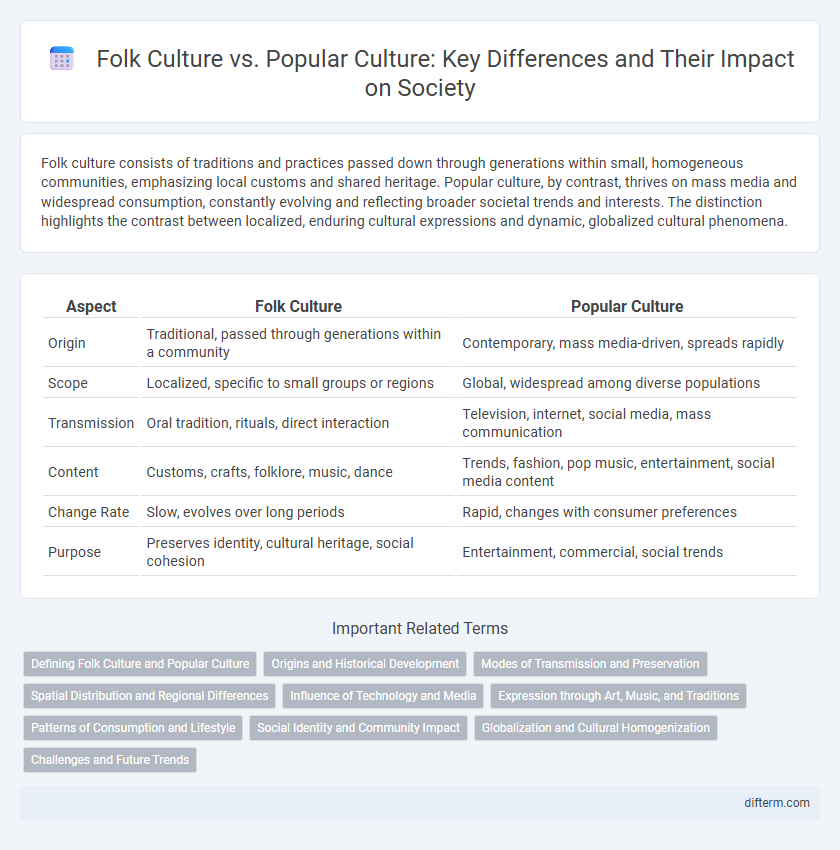Folk culture consists of traditions and practices passed down through generations within small, homogeneous communities, emphasizing local customs and shared heritage. Popular culture, by contrast, thrives on mass media and widespread consumption, constantly evolving and reflecting broader societal trends and interests. The distinction highlights the contrast between localized, enduring cultural expressions and dynamic, globalized cultural phenomena.
Table of Comparison
| Aspect | Folk Culture | Popular Culture |
|---|---|---|
| Origin | Traditional, passed through generations within a community | Contemporary, mass media-driven, spreads rapidly |
| Scope | Localized, specific to small groups or regions | Global, widespread among diverse populations |
| Transmission | Oral tradition, rituals, direct interaction | Television, internet, social media, mass communication |
| Content | Customs, crafts, folklore, music, dance | Trends, fashion, pop music, entertainment, social media content |
| Change Rate | Slow, evolves over long periods | Rapid, changes with consumer preferences |
| Purpose | Preserves identity, cultural heritage, social cohesion | Entertainment, commercial, social trends |
Defining Folk Culture and Popular Culture
Folk culture consists of traditional practices, customs, and artifacts passed down within small, homogeneous communities, often tied to rural or isolated areas with a strong emphasis on communal values and heritage. Popular culture encompasses mainstream, widespread trends, entertainment, and lifestyles influenced by mass media and consumerism, typically evolving rapidly and reflecting diverse urban or globalized societies. The distinction lies in folk culture's emphasis on preservation and authenticity versus popular culture's focus on innovation and broad appeal.
Origins and Historical Development
Folk culture originates from rural, isolated communities and is traditionally transmitted orally and through customs, reflecting the lifestyle and values of specific groups over centuries. Popular culture emerges from urban centers and mass media, evolving rapidly to respond to contemporary trends and consumer demands since the late 19th century industrialization. The historical development of folk culture is deeply rooted in tradition and continuity, whereas popular culture is characterized by innovation, commercialization, and global diffusion.
Modes of Transmission and Preservation
Folk culture is primarily transmitted through oral tradition, rituals, and face-to-face interactions within closely-knit communities, ensuring the preservation of unique customs and practices over generations. Popular culture spreads rapidly through mass media, digital platforms, and commercial channels, facilitating widespread adoption but often leading to quicker cultural transformations. The preservation of folk culture relies on active participation and community engagement, while popular culture depends largely on media repetition and consumer trends.
Spatial Distribution and Regional Differences
Folk culture is typically localized, with spatial distribution confined to small, homogeneous groups often in rural areas, exhibiting strong regional differences shaped by tradition and environment. Popular culture spreads rapidly across large, heterogeneous populations through mass media and globalization, leading to widespread uniformity and diminished regional distinctions. This contrast highlights how folk culture maintains distinct regional identities, while popular culture promotes spatial diffusion and cultural homogenization.
Influence of Technology and Media
Folk culture is traditionally preserved through oral transmission and localized customs, relying less on technology and media for dissemination. Popular culture rapidly spreads and evolves through digital platforms, mass media, and social networks, amplifying global connectivity and cultural exchange. Technological advancements have blurred boundaries, allowing folk culture to gain new audiences while popular culture adapts to emerging digital trends.
Expression through Art, Music, and Traditions
Folk culture expresses identity through localized art forms, traditional music, and rituals passed down through generations, reflecting community values and history. Popular culture, driven by mass media and commercialization, features widely accessible artistic styles, contemporary music trends, and globalized traditions that rapidly evolve. The contrast highlights folk culture's intimate connection to heritage, while popular culture emphasizes innovation and widespread appeal.
Patterns of Consumption and Lifestyle
Folk culture exhibits localized patterns of consumption tied to traditional practices and community-based lifestyles, often relying on natural resources and handcrafted goods. Popular culture demonstrates widespread consumption patterns influenced by mass media and global markets, characterized by dynamic trends and consumerism. The lifestyle in folk culture emphasizes preservation of heritage and social cohesion, whereas popular culture promotes individualism and rapid adaptation to new styles.
Social Identity and Community Impact
Folk culture, rooted in localized traditions and customs, reinforces social identity by preserving unique community values and practices that foster a strong sense of belonging. Popular culture, characterized by mass media and widespread trends, shapes social identity through shared experiences across diverse populations, influencing collective behaviors and attitudes. While folk culture strengthens community cohesion through heritage, popular culture drives social integration by connecting individuals beyond geographical and cultural boundaries.
Globalization and Cultural Homogenization
Folk culture, characterized by localized customs, traditions, and practices, often resists the widespread influence of globalization, preserving unique cultural identities. Popular culture, driven by mass media and global corporations, accelerates cultural homogenization by promoting standardized entertainment, fashion, and consumer products worldwide. This tension between folk and popular culture highlights the impact of globalization on cultural diversity, with popular culture contributing to the erosion of distinct folk traditions.
Challenges and Future Trends
Folk culture faces challenges in preservation due to globalization and digital media overshadowing traditional practices and oral histories. Popular culture, driven by mass media and technology, evolves rapidly, influencing global trends but often homogenizing diverse cultural expressions. Future trends indicate a convergence where digital platforms may support the revitalization of folk culture while popular culture adapts to incorporate localized and authentic elements.
Folk Culture vs Popular Culture Infographic

 difterm.com
difterm.com